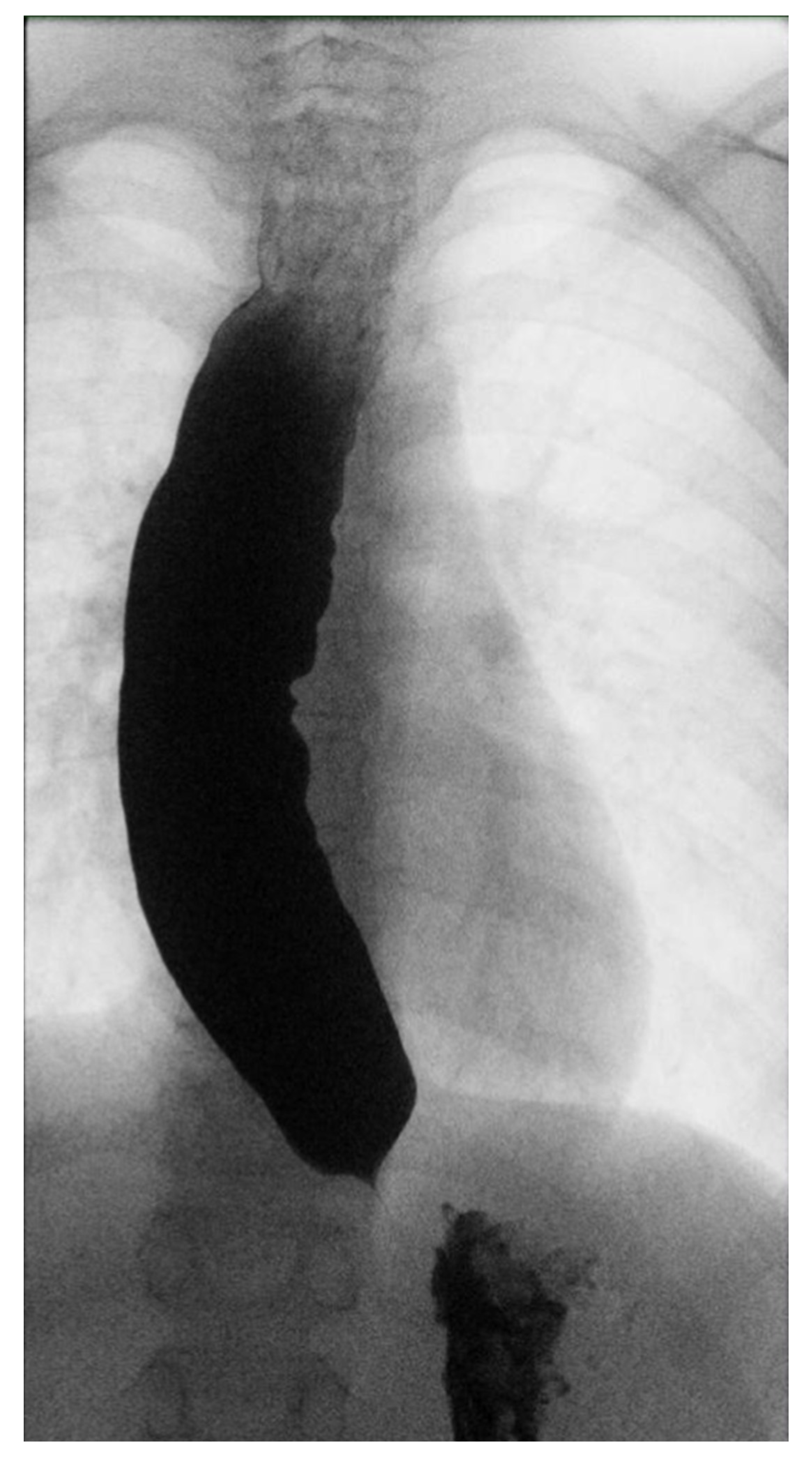Dysphagia in Children, Do Not Blame Eosinophils Too Quickly
Abstract
:1. Case
2. Discussion
Author Contributions
Funding
Institutional Review Board Statement
Informed Consent Statement
Data Availability Statement
Conflicts of Interest
References
- Dodrill, P.; Gosa, M.M. Pediatric dysphagia: Physiology, assessment, and management. Ann. Nutr. Metab. 2015, 66, 24–31. [Google Scholar] [CrossRef] [PubMed]
- Zdanowicz, K.; Kucharska, M.; Sobianec-Lotowska, M.E.; Lebensztejn, D.M.; Daniluk, U. Eosinophilic Esophagitis in Children in North-Eastern Poland. J. Clin. Med. 2020, 9, 3869. [Google Scholar] [CrossRef] [PubMed]
- Noel, R.J.; Putnam, P.E.; Rothenberg, M.E. Eosinophilic Esophagitis. N. Engl. J. Med. 2004, 351, 940–941. [Google Scholar] [CrossRef] [PubMed]
- Gentile, N.; Katzka, D.; Ravi, K.; Trenkner, S.; Enders, F.; Killian, J.; Kryzer, L.; Talley, N.J.; Alexander, J. Oesophageal narrowing is common and frequently under-appreciated at endoscopy in patients with oesophageal eosinophilia. Aliment. Pharmacol. Ther. 2014, 40, 1333–1340. [Google Scholar] [CrossRef] [PubMed]
- Menard-Katcher, C.; Swerdlow, M.P.; Mehta, P.; Furuta, G.T.; Fenton, L.Z. Contribution of esophagram to the evaluation of complicated pediatric eosinophilic esophagitis. J. Pediatr. Gastroenterol. Nutr. 2015, 61, 541–546. [Google Scholar] [CrossRef] [PubMed] [Green Version]
- Laserna-Mendieta, E.; Casabona, S.; Savarino, E.; Perelló, A.; Pérez-Martínez, I.; Guagnozzi, D.; Barrio, J.; Guardiola, A.; Asensio, T.; la Riva, S.; et al. Efficacy of Therapy for Eosinophilic Esophagitis in Real-World Practice. Clin. Gastroenterol. Hepatol. 2020, 18, 2901–2911. [Google Scholar] [CrossRef] [PubMed]
- Okoromah, C.A.N.; Ekure, E.N.; Lesi, F.E.A.; Okunowo, W.O.; Tijani, B.O.; Okeiyi, J.C. Prevalence, profile and predictors of malnutrition in children with congenital heart defects: A case-control observational study. Arch. Dis. Child. 2011, 96, 354–360. [Google Scholar] [CrossRef] [PubMed] [Green Version]
- Choné, A.; Familiari, P.; von Rahden, B.; Desai, P.; Inoue, H.; Shimamura, Y.; Eleftheriadis, N.; Yamashita, K.; Khashab, M.A.; Shiwaku, H.; et al. Multicenter Evaluation of Clinical Efficacy and Safety of Per-Oral Endoscopic Myotomy in Children. J. Pediatr. Gastroenterol. Nutr. 2019, 69, 523–527. [Google Scholar] [CrossRef] [PubMed]
- Prpic, I.; Huebner, A.; Persic, M.; Handschug, K.; Pavletic, M. Triple A Syndrome: Genotype-Phenotype Assessment. Clin. Genet. 2003, 63, 415–417. [Google Scholar] [CrossRef] [PubMed]
- Van Lennep, M.; van Wijk, M.P.; Omari, T.I.M.; Benninga, M.A.; Singendonk, M.M. Clinical management of pediatric achalasia. Expert Rev. Gastroenterol. Hepatol. 2018, 12, 391–404. [Google Scholar] [CrossRef] [PubMed]
- Juzaud, M.; Lamblin, M.D.; Fabre, A.; Alessandrini, M.; Baumstarck, K.; Bazin, C.; Esteve, C.; Laborde, N.; Osei, L.; Michaud, L.; et al. Correlation between clinical signs and high-resolution manometry data in children. J. Pediatr. Gastroenterol. Nutr. 2019, 68, 642–647. [Google Scholar] [CrossRef] [PubMed]


Disclaimer/Publisher’s Note: The statements, opinions and data contained in all publications are solely those of the individual author(s) and contributor(s) and not of MDPI and/or the editor(s). MDPI and/or the editor(s) disclaim responsibility for any injury to people or property resulting from any ideas, methods, instructions or products referred to in the content. |
© 2022 by the authors. Licensee MDPI, Basel, Switzerland. This article is an open access article distributed under the terms and conditions of the Creative Commons Attribution (CC BY) license (https://creativecommons.org/licenses/by/4.0/).
Share and Cite
Debourdeau, A.; Gonzalez, J.-M.; Barthet, M.; Vitton, V. Dysphagia in Children, Do Not Blame Eosinophils Too Quickly. Children 2023, 10, 63. https://doi.org/10.3390/children10010063
Debourdeau A, Gonzalez J-M, Barthet M, Vitton V. Dysphagia in Children, Do Not Blame Eosinophils Too Quickly. Children. 2023; 10(1):63. https://doi.org/10.3390/children10010063
Chicago/Turabian StyleDebourdeau, Antoine, Jean-Michel Gonzalez, Marc Barthet, and Véronique Vitton. 2023. "Dysphagia in Children, Do Not Blame Eosinophils Too Quickly" Children 10, no. 1: 63. https://doi.org/10.3390/children10010063




